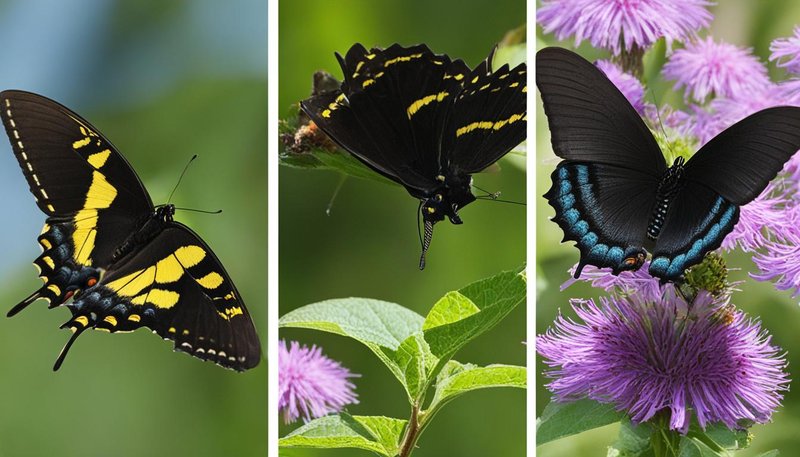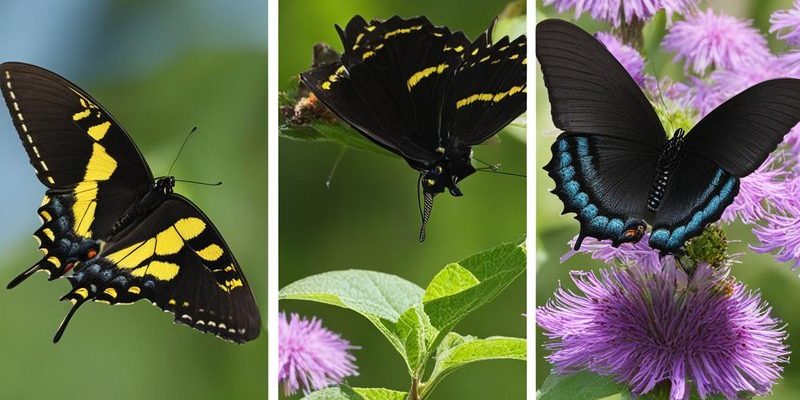
In this blog post, we’re diving into the world of the Swallowtail butterfly and exploring how it stacks up against insects that share some of its charming features. It’s like a fun game of “which one doesn’t belong?” We’ll chat about what makes Swallowtails unique, who their closest relatives are, and how you can tell them apart just by looking. So grab your coffee, and let’s spread our wings!
What Is a Swallowtail Butterfly?
Swallowtail butterflies belong to the family Papilionidae and are easily recognizable due to their striking tails that extend from the hindwings, resembling a swallow’s tail. These butterflies come in various species, each flaunting its own unique color patterns, but they generally sport bright yellow or blue hues with distinctive black markings. Just picture a tiny piece of art flitting through your garden—that’s a Swallowtail!
These butterflies are not just pretty faces; they play an essential role in our ecosystem. As pollinators, they help plants reproduce by transferring pollen as they sip nectar. This relationship is vital for many flowering plants, contributing to food production and biodiversity.
Swallowtails can be found in various habitats, including forests, wetlands, and gardens, making them a delightful sight in many outdoor spaces. Their life cycle includes several stages: egg, caterpillar (larva), pupa (chrysalis), and adult butterfly. Each stage brings its own set of adventures, particularly for the caterpillars, which often have unique colors and patterns that help them blend into their surroundings.
How Do Swallowtails Compare to Monarch Butterflies?
You might be wondering how the Swallowtail measures up against the ever-popular Monarch butterfly. Both are beautiful and serve important ecological roles, but they come from different families. Monarchs belong to the family Nymphalidae and are easily recognized by their orange and black coloration.
When comparing the two, one key factor is their migration patterns. Monarchs are famous for their long migrations, traveling thousands of miles to escape cold winters. Swallowtails, on the other hand, don’t typically migrate far. Instead, they might move locally to find food or suitable breeding sites.
Additionally, Swallowtail caterpillars often have a unique “false eye” pattern that helps deter predators by mimicking the eyes of larger animals, while Monarch caterpillars are known for their toxicity, which they acquire from the milkweed they consume. This makes them unappealing to hungry birds.
Swallowtail vs. Painted Lady Butterflies
Another butterfly that often comes up in conversations about beauty is the Painted Lady. With its intricate mosaic of orange, black, and cream colors, the Painted Lady is a stunning sight. They belong to the family Nymphalidae too, just like Monarchs.
While Swallowtails are known for their tails, Painted Ladies have a more traditional wing shape. Their caterpillars are quite different as well; they often camouflage themselves among plant material, unlike the Swallowtail’s eye-catching design. If you see a butterfly resting on a flower, you might spot the Swallowtail quickly due to its larger size compared to the smaller Painted Lady.
Both species can be found in similar habitats, but Painted Ladies are more adaptable, thriving in a wider range of environments. This adaptability means they can migrate further and more frequently, often leading to larger populations in certain areas.
Swallowtails and Their Look-Alikes: The Plume Moths
Now, let’s shift gears and look at some insects that aren’t butterflies but still share some visual similarities with Swallowtails—specifically, plume moths. These moths often have slender bodies and fringed wings that give them a unique, delicate appearance.
While they might not be as colorful as Swallowtails, their intricate wing structures can resemble the butterfly’s elegant grace. However, plume moths are much smaller and have a different flight pattern. Instead of the smooth, fluttering motion of a Swallowtail, you’ll notice plume moths tend to hover and dart around, almost like they’re dancing.
One of the easiest ways to distinguish between the two is by observing their body structure. Plume moths have a more elongated form and their wings fold back in a distinctive way, while a Swallowtail’s wings are broader and more open when at rest.
Identifying Swallowtails: Key Features to Look For
If you’re eager to identify a Swallowtail butterfly in the wild, there are several distinctive features to keep an eye on. First, the tail-like extensions at the hindwings are a major giveaway. This is often the most noticeable trait that sets them apart from other butterflies.
Another thing to notice is the vibrant coloring. While many butterflies boast bright colors, Swallowtails often have bold yellows, blues, and black patterns. Their size is also a factor—Swallowtails tend to be larger than many other butterflies, which can help you spot them more easily.
Pay attention to the behavior as well. Swallowtails often bask in the sun with their wings spread wide, showing off their striking colors. This not only helps them warm up but also acts as a display to attract mates.
Conservation and the Future of Swallowtail Butterflies
Like many creatures in our ecosystem, Swallowtail butterflies face threats from habitat loss, climate change, and pesticides. This makes conservation efforts crucial. By providing natural habitats, planting native flowers, and reducing chemical use, we can help ensure these butterflies thrive.
Engaging in community science projects, such as butterfly counts or habitat restoration efforts, can also make a difference. It’s a way to connect with nature and contribute to the preservation of these beautiful insects. Plus, encouraging butterfly-friendly gardens can bring not just Swallowtails but a wide variety of other pollinators to your backyard.
Understanding these challenges helps us appreciate the beauty of Swallowtails even more. With a little effort, we can work together to help protect them and their habitats for years to come.
Wrapping Up: The Beauty of Swallowtails and Their Kin
In conclusion, comparing the Swallowtail butterfly to similar insects reveals a fascinating world filled with diversity and beauty. From the Monarch’s long migrations to the delicate dance of plume moths, each species contributes to our ecosystem in unique ways.
When you spot a Swallowtail flitting around, take a moment to appreciate not just its beauty, but also the role it plays in nature. Whether you’re a nature enthusiast or a casual observer, understanding these incredible insects can deepen your connection to the natural world. And remember, every little effort counts when it comes to protecting these fluttering friends.

